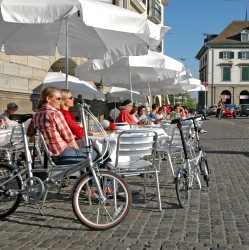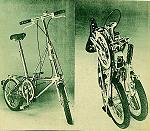 |
 |
 |
The Dahon story
begins in 1975. At the time, Dr. David Hon, our founder, was a physicist
at Hughes Aircraft Corporation, in California, working on highly classified
government research projects. Considered a leading expert in solid-state
laser technology, Dr. Hon had already been awarded numerous U.S. patents
(Patent
4,344,042, Patent
4,178,561, Patent
4,019,159 and Patent
4,010,397) for advancements in laser technology. Breakthrough laser
technology that he and his team developed would later be used on NASA space
shuttles, US missile guidance systems, and laser-guided anti-aircraft guns.
Yet despite his success, Dr. Hon eventually found the work at Hughes Aircraft
unfulfilling, because his energies were devoted to instruments of war, rather
than for the betterment of society. Then, in 1975 came the oil and gas crisis
and the seed for Dahon was sown.
 One
afternoon, in his third week of waiting in hour long lines to buy gasoline
for his car, Dr. Hon was struck by the magnitude of the world's dependence
on a oil, a non-renewable resource that would likely be depleted within
the lifetime of his grandchildren. One
afternoon, in his third week of waiting in hour long lines to buy gasoline
for his car, Dr. Hon was struck by the magnitude of the world's dependence
on a oil, a non-renewable resource that would likely be depleted within
the lifetime of his grandchildren.
Brain-storming for solutions to weaken the world's dependence on oil, Dr.
Hon ended up going back to his primary mode of transportation in college
- the bicycle. Totally clean, and just as important, cheap enough for people
around the world to access, Dr. Hon considered the bicycle to be a good
candidate as a solution. However, the bicycle as it existed at that time
was not without shortcomings. While the bicycle was perfect for short trips,
it was not practical for longer trips, for example, if you lived 30 miles
from work. The bicycle needed to be improved, transformed, to make it more
broadly functional. It needed to integrate more readily with other forms
of more environmentally sustainable transport, like trains and subways.
Dr. Hon's solution - a portable folding bicycle.Next came the hard part:
turning his ideas into reality. Working evenings and weekends in his garage
over the next seven years, Dr. Hon built dozens of dozens of prototypes,
trying to perfect a folding bicycle that would maintain the riding performance
of a regular bicycle but would fold quickly and to a compact size.
Finally, in 1982, Dr. Hon introduced the first Dahon folding bicycle to
worldwide acclaim. At design competitions around the world, the first Dahon
folding bicycle proceeded to win award after award. Full of optimism, Dr.
Hon visited major bicycle manufacturers around the world, hoping to find
a company to either license his design or build the bike for him. But not
surprisingly, none of big companies were interested in his revolutionary
new idea.
Undaunted and committed to his vision of environmentally-sustainable transportation,
Dr. Hon decided to risk everything and build the bike himself. He quit his
job, gathered $3 million dollars in venture funding, re-located to Taiwan,
and built a factory. By 1983, Dahon folding bicycles were rolling off the
assembly line.
Today, almost two million bicycles later, we can proudly say that
Dahon has made a difference. From San Francisco to Amsterdam to Rio
de Janeiro to Tokyo, people are using our bicycles to get from point
A to point B. Governments are integrating portable folding bicycles
into their plans for mass transportation. And every one of those big
bicycle companies that Dr. Hon visited 20 years ago have now jumped
on the folding bike bandwagon.
We're happy to have made such a difference in the lives of people
all around the world. But rest assured that we aren't slowing down
- there are many more revolutions to be started. |
|
 |
 |
|


